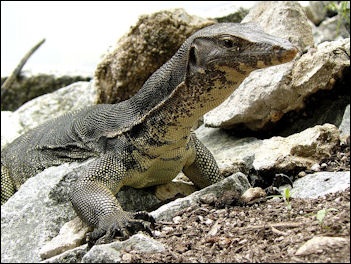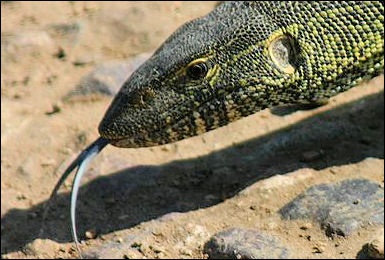MONITOR LIZARDS

Monitor lizard
All monitor lizards have a tapered head, visible ear openings, a long and slender neck, eyelids, round pupils and powerful jaws. The tail of most monitor lizard species is about two thirds its body length. Unlike most so-called cold-blooded animals, monitor lizards have a high metabolic rate. They burn a lot of energy rapidly. Some species burn up as much energy as mammals. Monitor lizards are nor prey for animals such as leopards because their skin is too thick.
Monitor lizards have forked tongues which they use for smelling. Their sense of smell is so acute they can determine from a long distance whether a snake is poisonous or non-poisonous, or whether another monitor in the area is male or female, resident or nonresident by detecting a few chemicals in the air or by sampling their tracks.
Monitor lizards have unblinking eyes and superb vision. They can determine if an object in the sky at a great distance is threatening or nonthreatening. One scientist saw a young monitor lizards racking a plane traveling at 35,000 feet.
Most lizards can’t breath and run at the same time. The rib muscles which expand the chest during each breath also brace the forelimbs during locomotion, especially running. The peripateric monitor lizards has developed an alternative way for air to reach the lungs when it moves. As the animal moves, specialized bones in its throat depress the throat causing the gullet to expand, creating a cavity for air to be stored in. When enough air flows into the cavity the lizard closes its mouth. Constriction of the throat pumps air into the lungs. The process is repeated the lizard moves..
Reptiles and Lizards

monitor lizard tongue
Reptiles are cold-blooded, hairless, egg-laying vertebrates. They are they divided into four orders: 1) snakes and lizards, 2) turtles, 3) crocodiles and alligators, and 4) the tuatara (a creature found in New Zealand that looks like a lizard). Most 7,200 of so reptile species are either lizards or snakes.
The ancestors of modern reptile are though to have emerged around 240 million years ago. The oldest fossils date to between 170 million and 200 million years ago. The most famous reptiles from the past are dinosaurs who many scientists believe are more closely related to modern birds than they are to modern reptiles.
Reptiles live mostly on land. They are found everywhere in the world except in polar regions. They are most plentiful in tropical regions.
Lizards and snakes are regarded as members of the same order (Squamata, meaning “scaly skins”) within the reptile class of animals because of anatomical similarities. Some true lizards such the glass snake are actually legless lizards and some snakes have rudimentary legs with their bodies. What distinguishes a lizard from a snake is that snakes have a flexible skull to swallow prey larger than they are. Lizards don’t have this.
Lizards evolved about 200 million years ago during the Jurassic Period. Their scaly skins helped protect their bodies from desiccation. The adaption allowed the move away from water into a drier environment. The lizard and snake branches are thought to have diverged about a 100 million years ago when a group of reptiles that evolved into snakes began adopting a burrowing lifestyle.
There are about 4,500 species of lizard, compared to about 4,000 mammals. Most lizards are predators with smaller species feeding on spiders, worms, larvae pill-bugs and various ground-dwelling insects. Large ones eat small mammals, eggs. Some even eat other lizards and their own kinds.
See Separate Article REPTILES, LIZARDS AND TURTLES factsanddetails.com
Monitor Lizard Behavior

Monitor lizards are very active. Unlike other iguanid lizards that are herbivores who leisurely go about their search for food, monitors are active predators who search high and low for their food. They are relatively fast walkers. lumbering along and moving their heads from side to side, flicking their tongues towards the ground to sense for the slightest movements or scents. When they sense something they often freeze like a pointer or some other hunting dog. Males of some species travel over home ranges of ten square miles while females cover about a third of that area.
Monitors are regarded as the most intelligent of all lizards. Monitors in captivity can count to six. Komodo dragons recognize their keepers. In the wild they can remember where hiding places are. If they are threatened they head to these places using the most direct route no matter where they are.
Monitors are good swimmers. They use their powerful tail to propel them through the water. Some have been observed swimming in the ocean, covering distances of 30 or more miles. Mostly they stick to rivers and swamps.
During the dry season when food is much less plentiful, monitor lizards conserve their energy by staying very still. One scientist observed a large male who stayed in a large tree for 72 consecutive days and at most moved from one branch to another. The exception to this is if a monitor lizard finds an abundant food supply and can afford to expend more energy.
Monitor Lizard Feeding Behavior

Monitor lizard feed on whatever they can find: insects, snails, eggs, snakes, small lizards, and occasional baby birds or mammals. One species was observed gorging on 100 snails one day, 200 grasshoppers and a four foot snake on other day, in addition to crickets and beetles. Komodo dragons have been known to kill water buffalo. A three-pound juvenile lace goannas (Australian monitor lizards) was observed eating a one-pound rabbit.
Monitor lizards cover fairly large hunting areas. They feast during the wet season so they have enough stored energy in the form of fat to last through leans times in the dry season, when favorite food such as crickets and beetles are much less plentiful
Monitors are alert and skilled hunters, and this is reflected by their dominance as hunters in many niches across the Old World. They are regarded as skilled and resourceful as many mammal species even though they often rely on completely different mechanism---such as their tongues rather than their noses as sense organs---to find food.
Many species feed primarily on other lizards and these species are often wise to trick of pursued lizards. For example, an escaping lizard often runs in a zigzag pattern to a place such as a bush or rock. Rather than following the lizards zigzag pattern the monitor lizard heads directly to the object the lizard is escaping to and catches it before it arrives. Other lizards escape to a tree by jumping on the tree and then spiral around the to back side, The monitor anticipates this and heads directly to the backside of the tree.
Species that feed on eggs buried in tunnels in the ground dig directly down to the eggs rather than try to enter through the tunnel entrance which is often a considerable distance away from the eggs. Other species use their tails to push fish into shallow water where they can pounce on them. Komodo monitors can sense carrion from seven miles away. They have been observed climbing to ridge tops so they can sniff the wind for carrion odors.
Monitor lizards often catch their prey and then head to some hidden place to kill and consume it. That way they don’t leave themselves exposed and become prey themselves and they don’t give away the places they are most likely to attack. Other lizards don’t do this..
Monitor Lizard Mating and Eggs

Females often go into estrus for a week or two in the middle of the dry season. This is the only time that males exert themselves as they rush to get at receptive females before the rivals in their home range do. The females are often widely separated. They alert potential male suitors by staking themselves out in a large tree or some other landmark, moving about very little and giving off a pheronome chemical that can be detected up to a mile away.
Males can pursue multiple partners by visiting the home ranges of several females. One small monitor lizard was observed visiting the territory of four females in 45 minutes. Of the females he visited he had mated with two of them already.
About five weeks after mating female monitor lizards lay 50 one- or two-ounce eggs, usually in underground nests. Having not eaten much for months, she has to reach deep into her fat and nutrients reserves to provide for her young. It is not uncommon for a female to drop in weight from 15 pounds to 9 pounds to after giving birth and incubating the eggs. Some species lay their eggs in termite mounds, They return to the mounds about nine months later to allow the hatchlings to exit.
Monitor Lizard Young
The eggs incubate for about four months and the hatchlings emerge in the middle of the wet season. Hatchlings have disproportionally large heads. They are wider than the lizard’s body and a quarter of the length of its entire body (excluding the tail). With these configurations it can swallow prey about the same size as itself.
Monitor lizards hatchlings are preyed upon by snakes and raptors. They have good vison and a keen sense of smell and can help them stay out of trouble. Still the they have a lot of obstacles to overcome and only about a third of young monitor lizards make it to their first birthday.
Image Sources: Wikimedia Commons
Text Sources: National Geographic, Natural History magazine, Smithsonian magazine, Wikipedia, New York Times, Washington Post, Los Angeles Times, Times of London, The Guardian, Top Secret Animal Attack Files website, The New Yorker, Time, Newsweek, Reuters, AP, AFP, The Economist, BBC, and various books and other publications.
Last updated November 2012
